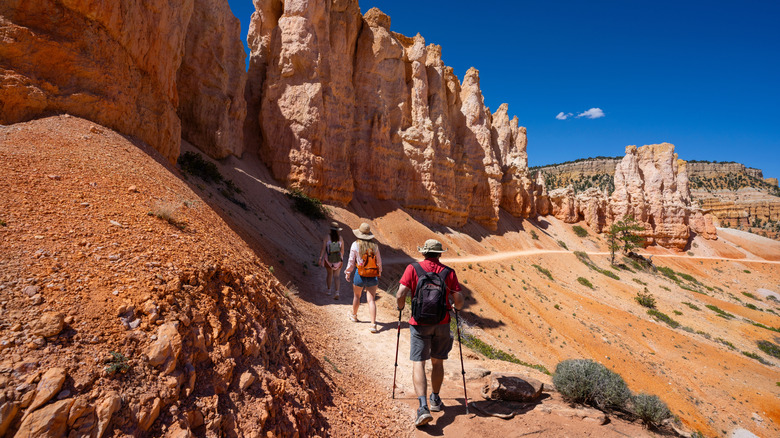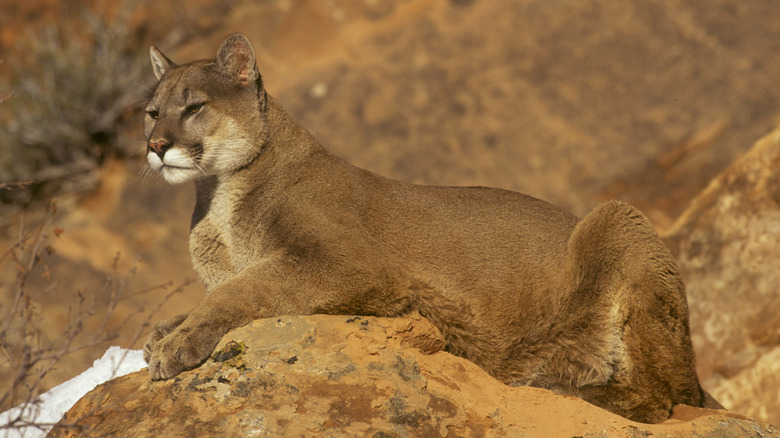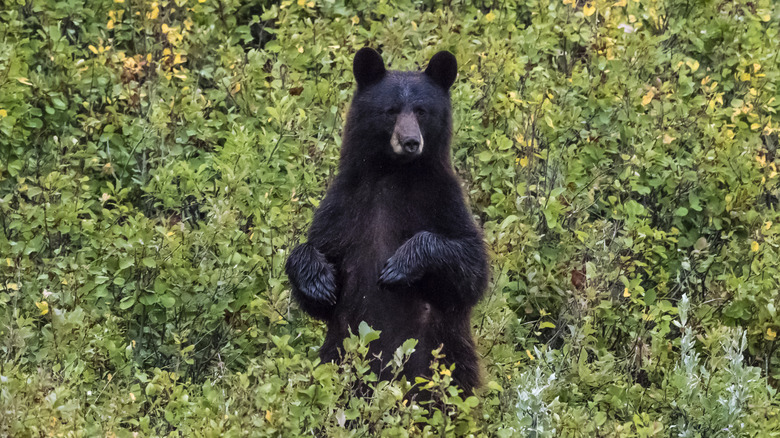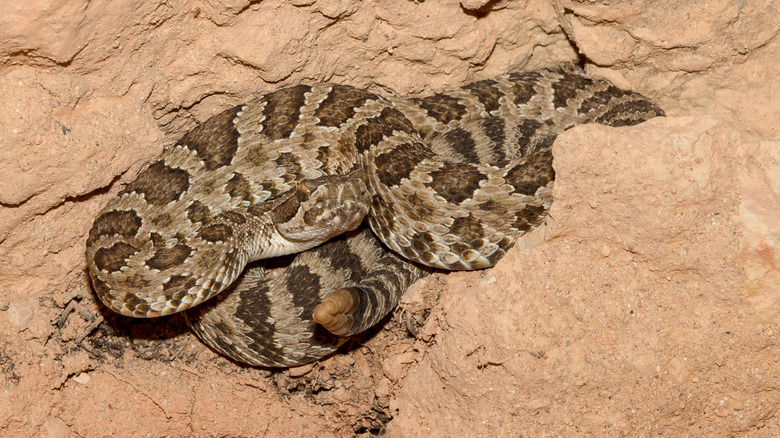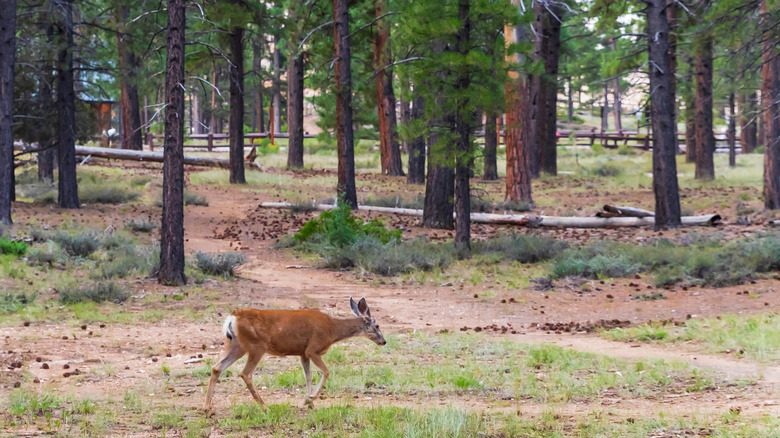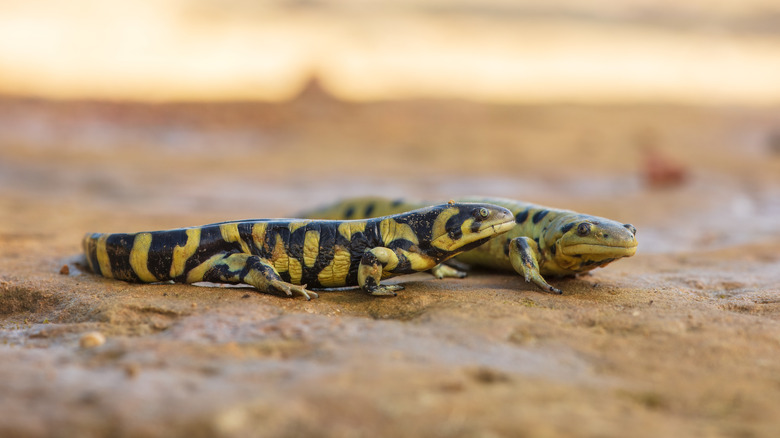5 Creatures To Beware Of When Visiting Bryce Canyon National Park
Bryce Canyon, despite being the ninth smallest national park in America, is full of striking orange rock formations and hoodoos that look like they are from an alien planet — making it one of those once-in-a-lifetime bucket list national parks to visit. Plus, on top of the beautiful views, Bryce Canyon also offers plenty of hiking, camping, cross-country skiing, as well as stargazing. In fact, the park hosts over 100 stargazing events a year, including an annual astronomy festival as well as guided full-moon hikes. However, while Bryce Canyon is an incredibly fun place to explore, it is still important to keep your safety in mind during your time there. Although Bryce Canyon doesn't have some of the most dangerous hikes in Utah, like the stunning but dizzying Angels Landing, it is still a large area that contains plenty of wilderness — and with wilderness come wild animals.
While most wild animals in national parks are wary of humans and want to avoid you as much as you want to avoid them, that doesn't mean that surprise wildlife encounters in Bryce Canyon don't happen. In fact, one Redditor on the r/NationalPark forum of the website detailed their own harrowing experience, writing, "My fiancée was growled at by a mountain lion on a main trail in Bryce Canyon." While everything turned out okay for that Redditor and they were able to simply back away from the big cat, it is still important to be aware of what dangerous wild animals you may encounter while spending time in Bryce Canyon.
Mountain lions
The most dangerous animal that you may accidentally encounter while exploring Bryce Canyon is likely the mountain lion. There are an unknown number of these big cats living inside Bryce Canyon National Park, and while sightings are rare because mountain lions tend to want to avoid humans, they do occur in the park — especially at night, in winter, or on backcountry trails that are less trafficked. Because of this, when in Bryce Canyon, you should always pay attention to any possible warning signs that a mountain lion might be nearby. These signs include scratch marks on trees and logs, paw prints, scat, and partially eaten animals that have been cached for later. If you see any of these warning signs as you are walking, it is a good idea to calmly leave the area as you have likely entered a mountain lion's territory.
If you encounter a mountain lion at Bryce Canyon, the protocol is to stay calm and slowly back away while facing the animal and maintaining eye contact. It is extremely important to never turn your back to a mountain lion or run away as this will make you appear more prey-like. Experts also recommend not crouching down and, instead, extending your arms to try and appear large. If a mountain lion approaches you, you should try to scare it away by shouting or throwing rocks and sticks at it. In the rare chance that the big cat attacks, you should always fight back.
American black bears
Although the brilliant orange and red canyons of Utah may not be where you would expect to encounter a black bear, there are around 1,500 to 3,000 black bears at any given time in the state. Estimates usually put the number of bears in Bryce Canyon as somewhere between 10 and 12. Like mountain lions, black bears tend to be people-shy and generally like to avoid areas that are loud and full of humans; however, that doesn't mean that accidentally running into a bear while camping in the backcountry is not possible.
So, while in Bryce Canyon, it is a good idea to be on the look out for bears, especially considering that in the United States, bear attacks are on the rise. Because of this, it's a good idea to bring bear spray with you while adventuring out in the backcountry in Bryce Canyon. When camping in bear country, it is important to follow proper food storage protocol by keeping all ingredients and food in a bear-proof container and hanging it in a tree at least 10 feet off the ground. It is also important to cook in an area away from your campsite and clean up any food scraps or garbage.
If you encounter a black bear while hiking or camping in Bryce Canyon, you should stand your ground and give the bear time to move around you. With black bears, it is important not to run away or play dead. You should also avoid making eye contact as this may be taken as a sign of aggression. If a black bear attacks you, you should fight back with bear spray, or even sticks and stones if nothing else is available.
Great basin rattlesnakes
The great basin rattlesnake is one of those animals that can be very dangerous because they are venomous and quite hard to see due to their brown and tan bodies that blend in so well with their desert surroundings. While death from a rattlesnake bite is pretty rare nowadays especially if the bite victim is able to get to a hospital quickly to be treated, it can still happen and is more likely to happen if you are out in the middle of nowhere far from the nearest hospital.
So, while out exploring Bryce Canyon, it is important to keep an eye and ear out for these venomous reptiles. You can also lower your chances of being bitten by making sure to stay on designated trails. You should also take caution to avoid walking through brushy or rocky areas. If you have to walk through these areas, you should always try to step on a rock or boulder and not over it — as stepping over a rock may surprise an unaware rattlesnake on the other side.
If you ever hear or see a rattlesnake while hiking, the first thing you should do is try and back away and give the snake some space. Like most other animals on this list, rattlesnakes would prefer to avoid humans and escape rather than attack. Because of this, one way to prevent being bitten is to give a rattlesnake around 10 feet of space so that it doesn't feel threatened. However, if you accidentally startle a snake and get bitten, you should try to remain calm and immediately call 911 for help from emergency services.
Mule Deer
Mule deer are native to the western United States and roam all around Bryce Canyon National Park looking for nice places to graze. In fact, many visitors report mule deer sightings not only in the canyons, but also around the visitors center parking lots as well alongside park roads. Because deer are generally portrayed in the media as kind and docile creatures, it is commonly believed that these elegant animals are harmless; however, mule deer are wild animals armed with hooves, antlers, and a weight of up to 300 pounds. Because of this, they are a lot more dangerous than most people realize, especially when trying to protect their young or during the fall mating season. In fact, there have been reports of both people and dogs getting attacked by mule deer.
So, what should you do if you see a mule deer in Bryce Canyon National Park? The first step is to make sure to give the animal plenty of space. If you think you are too close or the animal starts to behave nervously (walking in a stiff and jerky way or bouncing up and down) then you should back away. It is also important to slow down if you spot a mule deer on the side of the road while driving as they are very quick and agile and can change direction unexpectedly.
Tiger salamanders
Tiger salamanders, although a rare sight because they tend to be only active at night, do live in Bryce Canyon National Park and typically congregate around Swamp Canyon and other water sources in the backcountry. Although you probably won't see a tiger salamander during your trip to Bryce Canyon, it is important to be aware of them because they are toxic. In fact, these yellow and black amphibians have a tail gland that can produce a toxic liquid when they feel threatened.
Luckily, the toxin secreted by tiger salamanders is only dangerous if ingested. So, while it is okay to observe salamanders in their wild habitats, you should never handle or touch a salamander. If you do, it is important to thoroughly wash the area that was in contact with the salamander. Furthermore, because salamanders can be rather cute and look a bit like frogs, you should carefully monitor children and pets while in Bryce Canyon National Park to make sure that they don't touch or lick these toxic critters.
